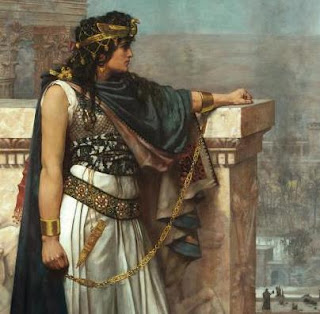
From the Michigan slates collection, a subject from Burrows cave - Cleopatra Selene. Here we see her funeral and her funerary elephant. This was drawn centuries after the fact, but it identifies this group as being from north Africa - they were Phoenician Carthaginians like the Burrows cave artists.

Gnostic dualism, more specifically, Persian dualism. The Manichaeans were known for creating books of drawings that illustrated their dualistic doctrine for those who do not read their language. On the slates we have the drawings and the explanations. The Burrows cave group had a different alphabet. They both use the mystic symbol written in Mesopotamian wedge writing - cuneiform, I think that mark may refer to their country like a flag would.

Dualism - their doctrine of the Son of the Right Hand and the Son of the Left Hand. The Cathars of southern France were also Manichaean in origin and had the same organization of the "Perfects" and the lower members who reproduced and farmed.
"The Knights Templar: The Mystery of the Warrior Monks"
... of the earlier Manichaean stream of Christianity, to which the Templars were connected...
East Central Europe in the Middle Ages, 1000-1500
... Albigensian heresy in that both were distant offshoots of Persian Manichaeism. ... by an organization of German warrior monks, the Teutonic Order of Knights...

The fortress castle of the Cathars, Montsegur.



Reconstructed model.

The Cathars in Europe, notice how their origin arrow has a question mark. Their origins were in the east, in Persia and Manichaean Turfan - the Mongolian desert.

Cathar country - Occitania and Northern Spain.
 Zosimos is one of the authors in the Gnostic Nag Hammadi library. Zenobia received Manichaean missionaries while she was in Alexandria.
"...refers to Palmyrene physical remains in Egypt. ... documents from China, Zenobia received Manichaean missionaries in Alexandria . Manichaean Texts from the Roman Empire.
... preservation is very poor, it appears to claim the Queen of Tadmor (Zenobia?) ... Egyptian Christian bishop in the late third century. "Against the Manichaeans ... Egypt (Roman province)
"The Roman province of Egypt was established in 30 BC after Octavian (the future emperor ... Zenobia, queen of Palmyra, took the country away from the Romans when she conquered ..... Not only did Arianism flourish, but other doctrines, such as Gnosticism and Manichaeism, either native or imported, found many followers." Zenobia invaded Egypt in 269 A.D.
Zosimos is one of the authors in the Gnostic Nag Hammadi library. Zenobia received Manichaean missionaries while she was in Alexandria.
"...refers to Palmyrene physical remains in Egypt. ... documents from China, Zenobia received Manichaean missionaries in Alexandria . Manichaean Texts from the Roman Empire.
... preservation is very poor, it appears to claim the Queen of Tadmor (Zenobia?) ... Egyptian Christian bishop in the late third century. "Against the Manichaeans ... Egypt (Roman province)
"The Roman province of Egypt was established in 30 BC after Octavian (the future emperor ... Zenobia, queen of Palmyra, took the country away from the Romans when she conquered ..... Not only did Arianism flourish, but other doctrines, such as Gnosticism and Manichaeism, either native or imported, found many followers." Zenobia invaded Egypt in 269 A.D.
 The lighthouse of Alexandria.
The lighthouse of Alexandria.
 Hypatia of Alexandria persecuted by the Byzantines as a Pythagorean, the Manichaeans were also persecuted by the Byzantines. Hypatia was killed in 415 A.D.
Hypatia of Alexandria persecuted by the Byzantines as a Pythagorean, the Manichaeans were also persecuted by the Byzantines. Hypatia was killed in 415 A.D.

 Byzantine Sophia.
Byzantine Sophia.
 Sophia Goddess of Wisdom.
Sophia Goddess of Wisdom.

 Sophia Wisdom also called Sophia Michael.
Sophia Wisdom also called Sophia Michael.










































